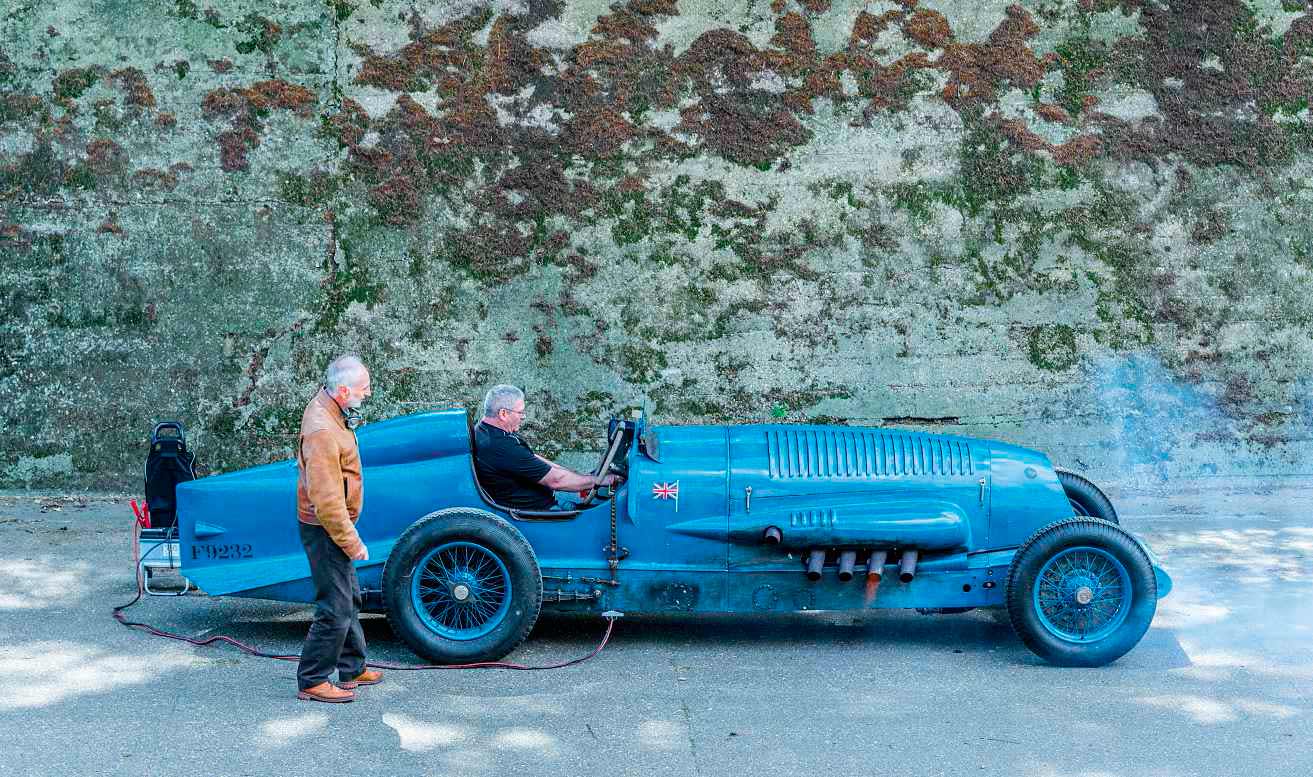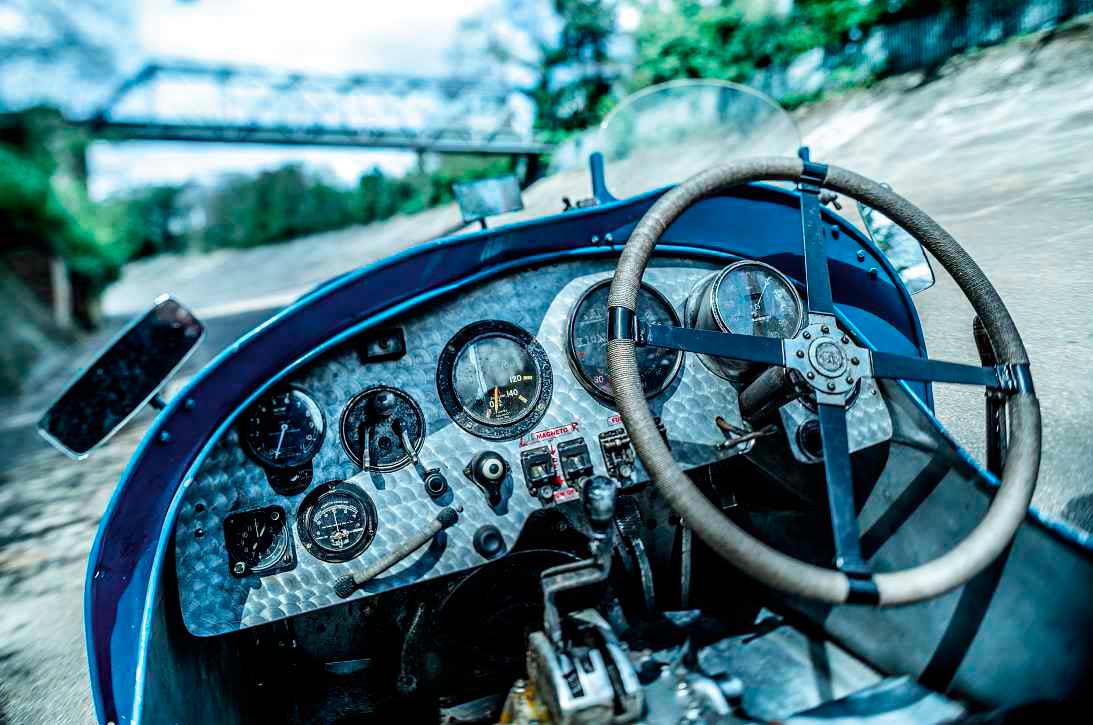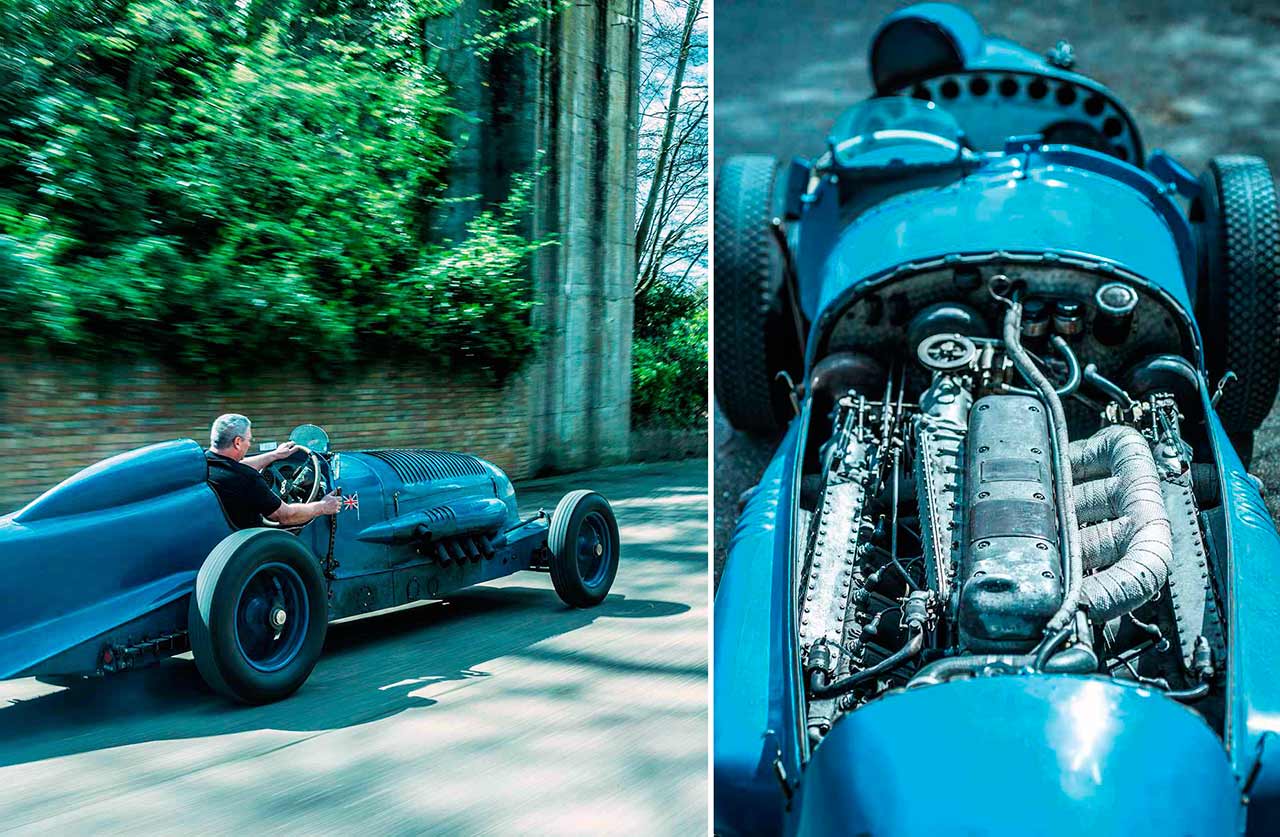
Blue bird homage. Campbell car re-created in a Surrey shed. Shades of Blue Bird. With a 24-litre Napier aero-engine at his disposal, this enthusiast built himself an homage to Malcolm Campbell’s record-breaker Words Delwyn Mallett. Photography Tim Andrew.
DELWYN MALLETT ‘In the 1960s, one of the first “classic” events I attended was the 60th anniversary Brooklands meeting at which the Napier- Railton was fired up. No engine excites me more than the Napier Lion broad arrow. Being propelled along the banking behind those 12 cylinders is a dream fulfilled.’
What do you do if one of your family heirlooms, bought by your granddad in the 1930s, happens to be one of the all-time great power units – namely a 24-litre, 12-cylinder, Napier Lion aero-engine? That’s exactly the situation in which Lord Lorne Jacobs (the Lord Boarstall – his title was an impulse purchase that amuses him and his friends and has proved helpful with airline upgrades) found himself. Fortunately, unlike most of us, he had the skills, mechanical expertise, and a garden shed in which to fulfill an ambition and build a car worthy of the fabulous engine.
Having known the engine since childhood and with a long-held fascination for the three Napier-powered recordbreakers of the 1920s and 1930s, Jacobs decided to construct an homage to the first of the famous trio, Malcolm Campbell’s 1927 Blue Bird. He wanted to use the engine in a car that could be raced in VSCC events and occasionally used on the road; only the Blue Bird in its original form came anywhere near to fitting the bill. Jacobs is quick to point out, however, that his Blue Bird is not a faithful replica, as the original was a three-ton giant and his is a mere 1½-ton dickybird – and all the more practical for it. He also wanted it to be an occasional two-seater, so he could share the fun.

Campbell’s Blue Bird was assembled in the bucolic surroundings of his splendid 16th Century country house and estate in Povey Cross, Surrey. Don’t be fooled by Jacobs’ title: his Blue Bird was built in a shed in the garden of his suburban semi in Northolt, Middlesex – which makes the achievement even more remarkable.
This Blue Bird’s story begins with Lorne Jacobs’ grandfather, Gordon Jacobs, and his friend, a Mr Renaulds, who worked in Napier’s drawing office. They bought, direct from the company, a marine version of the Lion engine with the intention of building their own car – an ambition that went unfulfilled. The Napier Power Heritage Trust has established that this Sea Lion engine, serial number 141, is the earliest known marinised version to have survived and was supplied to Portsmouth marine engineers Vosper in 1930.
The engine eventually made its way from long-term storage in Lorne’s father’s woodyard to Lorne’s living room. (The ultimate den decoration? Yes, he is divorced…) In 2009, his sitting room a little over-crowded, he embarked on the task of not only getting the motor running but building a car in which to run it.
Jacobs Jr accumulated his mechanical skills during 35 years working on Bugattis and Bentleys, and has history with big ‘specials’, having constructed several based on the 1930s 5.0-litre, six-cylinder Siddeley Special. Curiously, and quite coincidentally, Sir Malcolm Campbell owned a 1936 Siddeley Special Vanden Plas sports tourer that, six decades later, formed the basis of one of Jacobs’ projects.
For its hibernation the Lion engine had been preserved in a coating of lanolin, which proved immensely difficult to remove – having assumed the consistency of, as Jacobs puts it, ‘the treacle you find in the corner of an old gearbox’. It took gallons of thinners and weeks of transferring the sticky mess from engine to brushes, rags, overalls, garage floor… The stuff even followed him into the house.

Even de-gunked, the engine remained seized, with the stubbornly immovable pistons requiring a touch of ingenuity. First, via an electric pump, Jacobs plumbed the engine into a three-litre bain marie, brought it to the boil, and circulated the boiling water through the block until it too reached 100ºC. Next, having prepared himself by buying 100 time-expired CO2 extinguishers at a knockdown price, he fired a jet of ice-cold CO2 up into each piston, inducing a rapid drop in temperature that allowed them to slip easily out of the stillhot block. Clever, huh?
As part of the comprehensive rebuild Jacobs had new pistons made in the USA, saving a pound per piston in weight. New con-rods were also made and all of the bearings replaced, white metal on the big ends, rollers on the crank. The six camshafts (the 12 cylinders are arrayed in three banks of four on a common crank) were reprofiled and the compression ratio increased from 5.8:1 to 8.5:1. The mods allow the engine to spin at 3200 rpm, 1000 more than in Campbell’s day. The original Napier brass specification plate atop the central bank of cylinders quotes power at 450-500bhp but Jacobs reckons that the rebuilt motor is now producing closer to 700bhp. He maintains that, even with the raised compression, the engine will run on practically any combustible liquid.
Once the engine had been reassembled and was sitting loosely on the chassis, Jacobs couldn’t resist a tentative fire-up – and fire was the unexpected result. With the giant carbs primed, he spun the engine over and, its throttles fully open, it instantly burst into life at full revs, belching flame in every direction – unpatriotically igniting a Union Flag decorating the garage wall. In such confined space, the noise, says Jacobs, was ‘absolutely shattering’.
Fortunately the roaring engine consumed the contents of its carbs in seconds and shut down without bringing the house down around it. Having established that he had a working engine, Jacobs pressed on with the chassis. He felt it important that the car was a Napier in spirit as well as power, and had acquired a 1921 Napier chassis as a basis. Running gear was sourced from a variety of vintage machines, the priority being strength to cope with the engine’s torque. The gearbox came from an Austin 20 and, on test, spat its teeth through the casing, not quite perforating Jacobs’ legs. A rethink resulted in a 1930 Bentley ‘D’ ’box that so far has proved trouble free – although Jacobs had the gears produced in modern steel and cryogenically hardened. The inboard centre change is via a substantial gate, fabricated by Jacobs and mounted on top of the ’box.

The rear axle is also Bentley, originally from a Speed Six, as are the rear brakes. The front axle is Delage; unusually for a record-breaker of the day, Campbell’s Blue Bird had front brakes so Jacobs has adapted those of a Minerva to fit. Converted to hydraulics, they have the added advantage of being wider than the perhaps more obvious choice of Bentley stoppers. The car runs on 19-inch wheels, not the special 35-inch ones of Campbell’s Blue Bird.
The body, entirely hand-formed by Jacobs in another shed, consists of seven pieces and can be dismounted in less than an hour. The length of the Napier chassis dictated the car’s size, though it’s scaled down by comparison with the original. Once the mechanical components were in position, Jacobs, with reference to the original Blue Bird plans and contemporary photographs, created a sectioned buck on the chassis with a central spine and cross-sections initially cut out of hardboard and then, when he was satisfied with the shape, faced with ply.
A good few hours then followed with sheets of aluminium hammered into shape before finishing on an English Wheel. From stem to stern, all of the panels have a gentle compound curve. The most difficult and time-consuming task was cutting and forming the 44 curved louvres in the bonnet, the 88 ends of which had to be individually hammered to shape. The gracefully faired nose shrouds the radiator, with a supplementary radiator concealed between the dumb irons. Even with two rads, cooling is marginal at low speed, so it’s no town car but it is fully road legal. Jacobs has ventured as far as the local pub.
Campbell’s Blue Bird required only a minimum of instruments but this one has a comprehensive array of dials and switches to monitor things. One gauge, however, is not dash-mounted but located in the floor immediately in front of the passenger seat, reading the oil in the tank that feeds the engine’s dry-sump system. Originally fitted under an aircraft wing and designed to be looked up at by ground crew, the internal works had to be rejigged by Jacobs for it to work upside down, and it’s calibrated in pints.
The dash-mounted fuel gauge, on the other hand, is calibrated in inches! To work out how much fuel is left in the 16-gallon tank one obviously has to know its dimensions, work out its volume, calculate the depth of a gallon of fuel and be good at mental arithmetic. Given that the beast does only 1½ miles to the gallon, this skill could be important.
Sitting at the foot of Brooklands’ banking, photos snapped, details detailed, it’s finally time to get moving. ‘Stand back or you might get singed,’ Jacobs warns before pressing the starter. As 24 litres of unsilenced aero-engine erupt into fire-spitting life, it gives new meaning to the phrase ‘Did the earth move for you?’
If you appreciate engines and have never stood close to a large aero-engine firing up, it’s time you did. Explosive, sonorous, reverberating, pulsating, roaring, exhilarating: choose your adjective. It’s not only the earth that moves, you can also feel your internal organs jiggling with the beat of the firing pulses. With so much metal, oil and water to get up to temperature, we leave the beast to idle, if that’s what you can call it, for five minutes before climbing aboard. Instructions: hands on cockpit sides, one foot on rear spring shackle, the other on the seat, step in, wiggle down into the cavity under the scuttle (avoiding kneecapping yourself on the aluminium dash and skinning your ankle on the gearbox. Not easy for a chap with a dodgy hip). It’s even more difficult for Jacobs on the other side of the cockpit, as there’s a large steering wheel to negotiate and he is currently waiting for knee replacements. As a result, if you are interested, Jacobs is seriously considering letting his Blue Bird fly to a new nest.
Once it’s warmed up, first gear gets us rolling; snick the ’box into second, hit the accelerator and wham! With a dozen 5½-inch diameter pistons doing their work and 700bhp on tap, acceleration is ear-splittingly sensational. Sadly, so little of the Brooklands banking remains navigable that our excursion is more of a drag strip sprint, disconcertingly executed at an acute angle to the horizontal, before we run out of track. There’s little more than a small handle on the dash (it wouldn’t be out of place on a kitchen drawer) for the passenger to hang on to, and ‘hanging on’ is an apposite description once on the banking.
That the John Cobb Napier-powered Railton, now in the Brooklands museum collection, toured the banking at more than 143mph not only boggles the mind but elicits feelings of profound admiration for the bravery of the drivers. Cobb described the experience as ‘like trying to see how far he could lean out of a first-floor window without falling out’. Even at the relatively low speeds we achieve, it’s easy to imagine what Cobb meant.
On flatter and smoother terrain, Jacobs reports that his Blue Bird will accelerate in a relentlessly linear fashion to around 120mph on its current gearing, all achieved with a magnificent bark from the exhaust stubs, and it will still smoke its tyres at 80mph. With the correct gearing and a brave pilot this Blue Bird should be theoretically capable of exceeding the 196mph that Campbell reached in 1929.
Despite Jacobs providing his Blue Bird with two seats, he rather inconveniently neglected to incorporate any wind-deflecting apparatus for the passenger. This means not only facing an ever-increasing gale but coping with the hot air, fumes and the odd flame wafting back from the array of open exhausts only a few feet ahead. Jacobs assures me that things are, in fact, not that different on his side of the snug cockpit. To be fair, he has also fabricated a roadgoing ‘Brooklands’ exhaust system that not only keeps the decibels down but exhales the hot gasses to the rear of the occupants.
In 2014, on the 90th anniversary of Sir Malcomb Campbell’s first World Record run there, Jacobs made a pilgrimage to Pendine Sands. He didn’t break any records but running along the beach in the tracks of Sir Malcolm Campbell was the fulfilment of a dream.
WHAT AN ENGINE
Uniquely, the Napier Lion has held air, land and water speed records.
David Napier started his precision engineering company in 1808 and spent much of the century acquiring a reputation for the quality of its work. However, as the 20th Century approached, the company, in the hands of his son, was in dire straits. In 1895 Montague Napier became the third generation to run the business – and it coincided with the arrival of the automobile.
With the encouragement of Australian-born entrepreneur and motor sport enthusiast SF Edge, Napier moved into car and engine production, becoming a major manufacturer of race-winners and record-breakers. When World War One broke out, Napier was contracted by the Government to produce Royal Aircraft Factory and Sunbeam aero engines but, critical of their performance, Montague decided to produce an engine of his own. The result was the Napier Lion, the work of Arthur John Rowledge, who later joined Rolls-Royce and became a key figure in the design of the Merlin engine.
The Lion first ran in 1917 and entered service at war’s end. Rowledge’s radical ‘broad-arrow’ configuration of three banks of four cylinders on a common crank made the engine compact. It was constructed largely of aluminium alloy with four valves per cylinder and twin overhead camshafts for an initial 450hp (later tuned to 1300hp in racing versions): the most powerful engine of the day. Napier built 160,000 through the 1920s and ’30s, fitted in more than 150 different types of aircraft, taking the World Airspeed Record in 1929 in a Gloster VI seaplane.

Malcolm Campbell was one of three British World Speed Record holders associated with the Napier engine, and the first to fit a Lion in a record-breaker. The 1927 Blue Bird was followed by Henry Segrave’s Golden Arrow in 1929 (he also took the water speed record in 1930 in the Napier-powered Miss England II), and John Cobb’s Napier-Railton in 1933. In 1938 Cobb mounted two Lion engines in his Railton Special, which ran post-war as the Railton-Mobil-Special, setting a record of 394.19mph, with a one-way 403.1mph: the first vehicle to exceed 400mph. In 1968 a Napier Sea Lion engine was installed in an 8 Litre Bentley chassis by David Llewellyn and Peter Morely, and is a regular presence at vintage meetings.
BLUE BIRD OR BLUEBIRD?
A tricky one, this. Malcolm Campbell used both versions. Campbell’s early racing cars carried a variety of names but in 1912 he adopted Blue Bird, a symbol of happiness, for all of his subsequent racers after the title of a hugely successful play running at London’s Theatre Royal, Haymarket. Written in 1908 by Belgian poet and playwright Maurice Maeterlink, its French title was L’Oiseau Bleu. Legend has it that, after seeing the play, Campbell raised a local ironmonger from his sleep, bought all the blue paint he had in stock and painted his car overnight, running it at Brooklands the following morning while still wet. By the time he had switched to chasing records on water, ‘Blue’ and ‘Bird’ had edged together to become Bluebird, and it continued in that form through Campbell’s son Donald’s record-breaking years.
‘Engine reassembled and sitting in the chassis, Jacobs couldn’t resist a tentative fire-up – and fire was the unexpected result’
TECHNICAL DATA FILE SPECIFICATIONS 1927 Napier Blue Bird homage
Engine 23,942cc 12-cylinder in broad-arrow configuration, DOHC per bank, Amal carburettors
Power c700bhp / SAE
Torque c1800lb ft / SAE
Transmission Four-speed manual, rear-wheel drive
Suspension Front: beam axle, leaf springs, friction dampers. Rear: live axle, leaf springs, friction dampers
Steering Worm and wheel
Brakes Drums
Weight c1500kg
Performance Top speed 196mph (theoretically).
0-60mph 6sec (approximately, in third, resulting in the need for new tyres…)


‘Rowledge’s “broad-arrow” configuration of three banks of four cylinders on a common crank made the engine compact’





